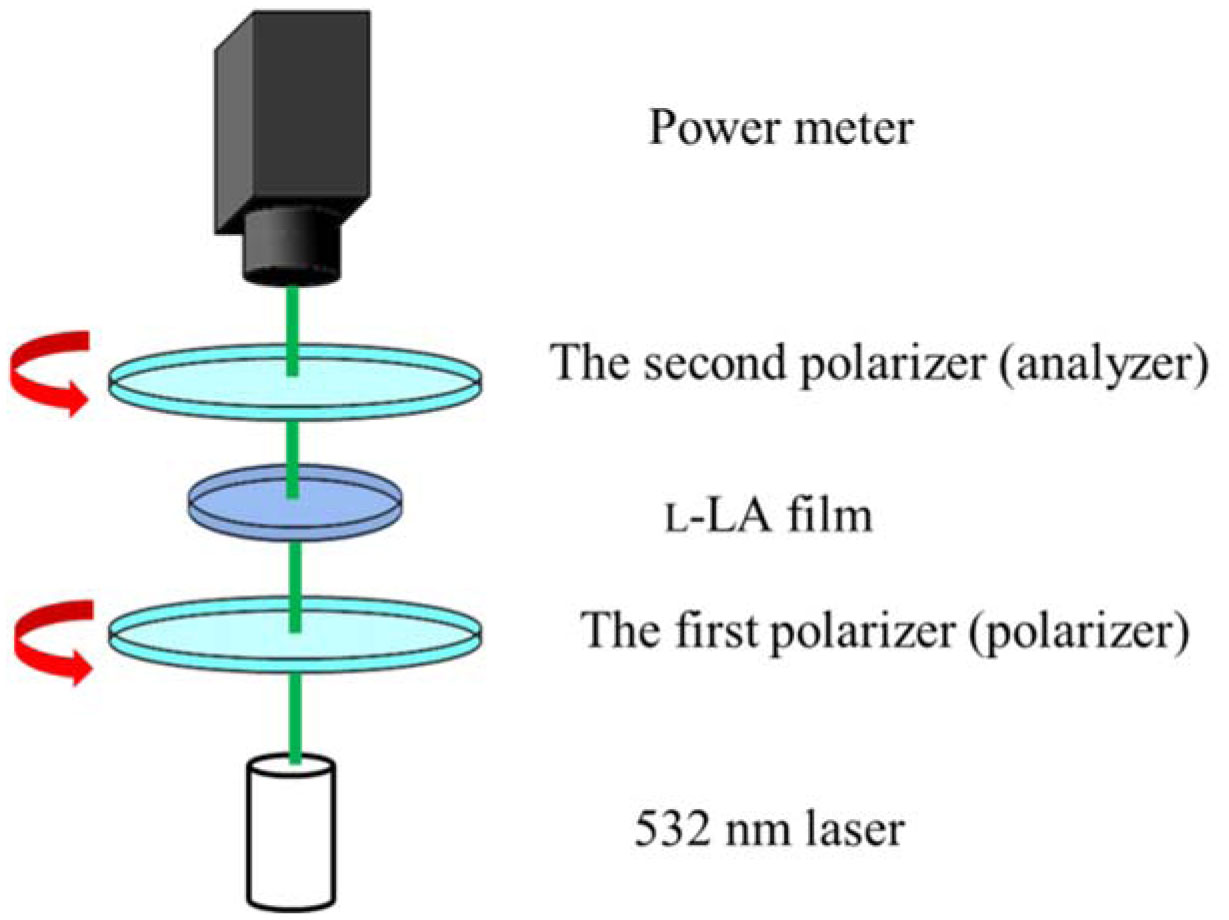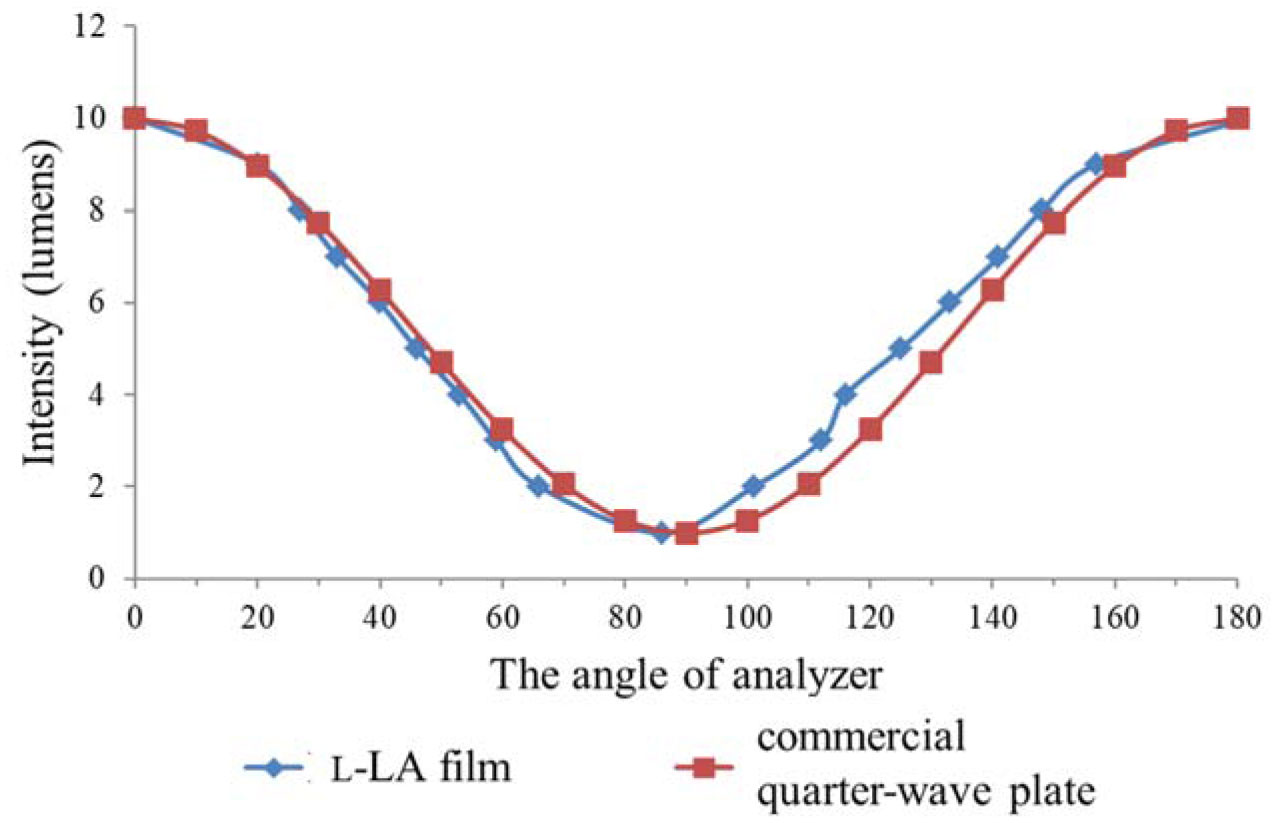1.
Introduction
A wave plate is an optical device that can alter the polarization state of a light wave. In general, two types of wave plates are used: a half-wave plate and a quarter-wave plate. The half-wave plate can shift the polarization direction of linearly polarized light, whereas the quarter-wave plate can convert linearly polarized light into circularly polarized light. Circularly polarized light is used in various applications, such as navigation satellite systems, 5G wireless communication, and underwater imaging [1]–[3]. Owing to the extensive development of polarization-based optics, circularly polarized light has been progressively applied in biomedical sciences. For example, circular dichroism (CD) spectroscopy is an analytical method used to study the secondary structures of proteins [4]. The Stokes vector of backscattered light depicted on a Poincaré sphere can be used to detect cancerous tissues [5]. Polarization-sensitive optical coherence tomography, which has been extended to full three-dimensional (3D) imaging at high speed and sensitivity, can be used in disease diagnosis [6]–[8].
The quarter-wave plate can be made of natural birefringent or form birefringent material, such as birefringent crystal, liquid crystal, polymer film, and subwavelength grating [9]–[12]. Usually, quartz is used because of its high damage threshold and retardation stability. Sometimes, polymer wave plates are employed owing to their high adjustability. Recently, chiral inorganic nanocomposites have also been developed as materials for circular polarized light emission, and this application is actively developed [13]. However, there is a need to develop wave plates based on biodegradable or biocompatible materials for more advanced applications in the field of biomedicine. Considering the application of chiral materials in circularly polarized photodetectors [14], chiral materials can be developed into wave plate materials owing to their optical activity. In this study, l-lactic acid (l-LA) was used to prepare quarter-wave plates. l-LA is a chiral molecule and metabolite in the human body. Moreover, lactic acid bacteria can produce a large amount of l-LA, it is an easily obtainable material [15].
2.
Materials and methods
2.1. Materials
l-LA was purchased from Sigma-Aldrich (St. Louis, Missouri, USA). Polyvinyl alcohol (PVA) was bought from First Chemical Works (Taipei, Taiwan). A linear polarizer and quarter-wave plate were purchased from TECH-SUN ELECTRON Co., Ltd. (Taipei, Taiwan). The circular polarizer film, CP75, was purchased from 3Dlens (Taipei, Taiwan). A microscope, TFB-6V, was purchased from ZAK-TECH (Taichung, Taiwan). A 532 nm laser was purchased from Soon-Link Co. Ltd. (Taipei, Taiwan). A photometer, TES-1337B, was purchased from TES-Electrical Electronic Corp. (Taipei, Taiwan). A power meter, PM100D, was purchased from THORLABS (New Jersey, USA).
2.2. Fabrication of l-LA films
The l-LA films were composed of l-LA and PVA. They were prepared using the following procedure: Suitable concentrations of the l-LA solutions were prepared in H2O. The l-LA solution (17 µL) was mixed with oversaturated PVA (8 µL), and the mixture was degassed via sonication. Thereafter, 25 µL of the mixture was injected into a 4 mm diameter mold made using a 3D printer. After solidification, a single-layer biocompatible film was formed. Depending on the experiment, multilayer biocompatible films were prepared by repeating the procedure.
2.3. l-LA film modification
The l-LA film modification was conducted using a modified microscope system. The system design is illustrated in Figure 1. The traditional biological optical microscope was used as the main body. The first linear polarizer was fixed between the light source and microscope carrier, and the second linear polarizer (analyzer) was fixed between the microscope carrier and the objective lens. The l-LA film was placed on the microscope carrier. The images were captured using a charge-coupled device (CCD). Both appearance of sample and the angle of the analyzer were observed by this system. Before placing the sample, the analyzer was adjusted until the vision under the CCD was dark. After setting on the l-LA film, the analyzer was rotated until the screen of CCD was dark, and the angle between l-LA film and analyzer was recorded.
2.4. Circular polarization experiment
The system used for the circular polarization experiment is shown in Figure 2. The light source was a 532 nm laser, and the diameter of laser spot was smaller than 0.3 cm. The laser sequentially penetrates the first polarizer (polarizer), l-LA film, and second polarizer (analyzer). Then, the signal was recorded by the power meter. In this experiment, the angle between the polarizer and l-LA film was set at 0° in the beginning. The signal intensity determined by the power meter was recorded by rotating the analyzer every 10° Whenever the polarizer was rotated 10°, the signal intensity was recorded by rotating the analyzer every 10° again.
2.5. Comparing the function between a commercial quarter-wave plate and l-LA film
The modified microscope system is shown in Figure 3. In this system, the white light sequentially penetrated the circular polarizer film, sample (l-LA film or commercial circular polar plate), and second polarizer (analyzer). Light signals were detected using a photometer. The change of light intensity was recorded under l-LA film or commercial quarter-wave plate conditions with the rotation of analyzer.
3.
Results and discussion
In this study, the two conditions that were varied during this experiment to determine the optimum conditions for the l-LA films were: 1) the concentration of the l-LA in the PVA solution and 2) the number of layers deposited onto a film. Figure 4 showed that the change in the concentration and number of layers influences the optical rotation. As the concentration increased, the optical rotation of the l-LA film increased. The R2 value of linear regression was 0.9632. The optical rotation also increases with an increase in the number of layers. The R2 value of linear regression was 0.9996. Changing the number of layers resulted in better linear regression than changing the concentration, and we wanted to reduce the influence of PVA. Therefore, 0.8% of l-LA was fixed, and the number of layers was changed in the subsequent experiments.
The appearance of l-LA films in five layers, six layers, seven layers, and twelve layers were shown in Figure 5. The thickness of six layers l-LA film was 100 µm. The parts, which were circled in yellow, stayed bright in the six layers and twelve layers. It means that circularly polarized light can pass through the l-LA film stably regardless of the angle of the l-LA film. This is the characteristic of a wave plate. On the other hand, the appearance images in Figure 5 show that the l-LA films were not uniform. This might be associated with the low precision of the molds made using a 3D printer or microcrystals with different orientations in the l-LA film. This is a limitation of this study. However, in further experiments, the l-LA film still showed good circular polarization characteristics. Figure 6 shows the results of the light intensity changes when the angles of the l-LA film were 30°, 70°, and 170°, and Table 1 presents the detailed results from 0° to 180°. Importantly, when the angle of the l-LA film was 30°, the changes in maximum and minimum light intensity were within 2% compared to the average light intensity. Because circularly polarized light can pass through the linear polarizer without intensity change at any angle, this result suggests that the l-LA film has the ability to form circularly polarized light. Furthermore, the light was linearly polarized when the angle of the l-LA film was 170°. The light was elliptically polarized when the angle was 70°. This indicates that the l-LA film possesses orientation-sensitive characteristics. This behavior is similar to that of wave plates constructed from birefringent materials [9]. In a previous study, a poly l-LA drop exhibited orientation-sensitive birefringent properties. It highly depended on the orientation of lamellar crystals [16]. Because l-LA is a monomer of poly l-LA, the l-LA film could form circularly polarized light.
To further validate the circular polarization function of the l-LA film, a commercial quarter-wave plate was used for comparison with the l-LA film. When circularly polarized light passes through a quarter-wave plate, it is transformed into linearly polarized light. Initially, a 532 nm laser was also used, but the data of l-LA film were not ideal. This might be because of the low penetration rate of the circular polarizer film and the l-LA film in the system of Figure 3. Therefore, white light was used in the microscope system because it contains a wider range of wavelengths. Figure 7 shows the lumen variation of the commercial quarter-wave plate and l-LA film. The result of the l-LA film was similar to that of the commercial quarter-wave plate. This proves that the l-LA film has the function of circular polarization.
From the materials, the l-LA film was composed of l-LA and PVA. PVA is a water-based transparent glue with low toxicity and high biocompatibility [17],[18]. It is a stable material, but degrades slowly in nature [19]. Therefore, PVA is widely used in biomedicines, cartilage replacements, and contact lenses [20],[21]. In contrast, l-LA can be produced from pyruvate via lactate dehydrogenase in humans and is eliminated in urine [22],[23]. In recent decades, lactic acid derivatives have been developed as biomaterials. For example, polylactic acid is used in cardiovascular devices, and chitosan lactate is used as a wound dressing [24],[25]. These reports assert that the l-LA film is a biodegradable and biocompatible product.
l-LA film has high flexibility, including changing the number of layers and concentration of l-LA. l-LA film could be applied in not only the optical range but also the microwave range. Recently, circularly polarized radiations for biomedical telemetry were widely studied. Fan et al. miniaturized circularly polarized antenna for in-body wireless communications [26]. Kaim et al. used a coplanar waveguide-fed ultra-miniaturized patch antenna to induce circularly polarized radiation. The antenna shows good performance for different tissue properties [27]. Blauert and Kiourti used quarter-wave plates to modify a bio-matched antenna without loss of generality [28],[29]. Depolarization of circularly polarized light scattered from biological tissues can provide valuable information for differentiating cancer tissues concealed in healthy tissues [30]. Biodegradable sensors have a unique opportunity for temporary medical implants for continuous body condition monitoring and in vivo sensing [31]. Thus, highly flexible l-LA film provides a choice for implantable medical devices.
4.
Conclusion
We used biodegradable and biocompatible materials, l-LA and PVA, to fabricate films. Circularly polarized light was successfully produced by the l-LA films, and the l-LA films showed orientation-sensitive characteristics. The l-LA film, with biodegradability and biocompatibility, is beneficial and possesses significant potential for application in biomedicine.










 DownLoad:
DownLoad:









